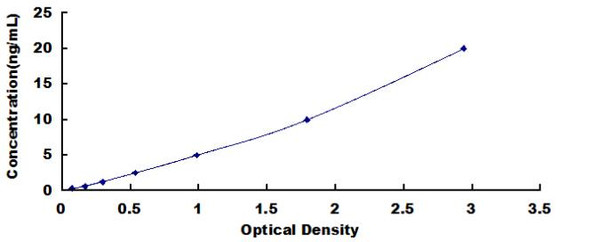Description
Rat BH3-interacting domain death agonist (Bid) ELISA Kit
The Rat BH3-Interacting Domain Death Agonist (BID) ELISA Kit is designed for the precise measurement of BID levels in rat samples including serum, plasma, and cell culture supernatants. With its high sensitivity and specificity, this kit offers reliable and reproducible results, making it a valuable tool for various research applications.BID is a critical protein that plays a key role in apoptosis, regulating cell death and survival pathways. Dysregulation of BID has been linked to various diseases such as cancer, autoimmune disorders, and neurodegenerative conditions, making it a significant biomarker for studying these diseases and potentially developing therapeutic interventions.
Overall, the Rat BID ELISA Kit provides researchers with a powerful tool to accurately quantify BID levels in rat samples, facilitating further study into the role of BID in various physiological and pathological processes.
| Product Name: | Rat BH3-interacting domain death agonist (Bid) ELISA Kit |
| SKU: | RTEB0376 |
| Size: | 96T |
| Target: | Rat BH3-interacting domain death agonist (Bid) |
| Synonyms: | p22 BID, BID |
| Assay Type: | Sandwich |
| Detection Method: | ELISA |
| Reactivity: | Rat |
| Detection Range: | 0.312-20ng/mL |
| Sensitivity: | 0.157ng/mL |
| Intra CV: | 5.7% | ||||||||||||||||||||
| Inter CV: | 7.8% | ||||||||||||||||||||
| Linearity: |
| ||||||||||||||||||||
| Recovery: |
| ||||||||||||||||||||
| Function: | Induces caspases and apoptosis. Counters the protective effect of Bcl-2. The major proteolytic product p15 BID allows the release of cytochrome c. |
| Uniprot: | Q9JLT6 |
| Sample Type: | Serum, plasma, tissue homogenates, cell culture supernates and other biological fluids |
| Specificity: | Natural and recombinant rat BH3-interacting domain death agonist |
| Sub Unit: | Forms heterodimers either with the pro-apoptotic protein BAX or the anti-apoptotic protein Bcl-2. p15 BID interacts with ITCH. |
| Research Area: | Neurosciences |
| Subcellular Location: | Cytoplasm Mitochondrion membrane When uncleaved, it is predominantly cytoplasmic. p15 BID translocates to mitochondria as an integral membrane protein. p13 and p22 BID are associated with the mitochondrial membrane (By similarity). |
| Storage: | Please see kit components below for exact storage details |
| Note: | For research use only |
| UniProt Protein Function: | BID: a pro-apoptotic member of the Bcl-2 superfamily. Targets intracellular membranes and contains a BH3 death domain. Heterodimerizes with either the pro-apoptotic protein BAX or the anti-apoptotic protein BCL2, antagonizing its protective effect. The activity of BID is regulated by Caspase 8-mediated cleavage, exposing the BH3 domain and significantly changing the surface charge and hydrophobicity, causing translocation to mitochondria where it triggers cytochrome c release. Multiple alternatively spliced variants have been found. |
| UniProt Protein Details: | Protein type:Apoptosis; Mitochondrial Cellular Component: mitochondrion; membrane; cell; cytoplasm; intracellular; cytosol Molecular Function:protein binding; ubiquitin protein ligase binding Biological Process: caspase activation; positive regulation of protein oligomerization; release of cytochrome c from mitochondria; apoptotic mitochondrial changes; positive regulation of apoptosis; positive regulation of protein homooligomerization; regulation of protein oligomerization; brain development; protein targeting to mitochondrion; protein homooligomerization; response to estradiol stimulus; regulation of cell proliferation |
| NCBI Summary: | involved in inducing Bax oligomerization in isolated mitochondrial outer membranes [RGD, Feb 2006] |
| UniProt Code: | Q9JLT6 |
| NCBI GenInfo Identifier: | 12083631 |
| NCBI Gene ID: | 64625 |
| NCBI Accession: | NP_073175.1 |
| UniProt Secondary Accession: | Q9JLT6,Q9JK60, |
| UniProt Related Accession: | Q9JLT6 |
| Molecular Weight: | 22,249 Da |
| NCBI Full Name: | BH3-interacting domain death agonist |
| NCBI Synonym Full Names: | BH3 interacting domain death agonist |
| NCBI Official Symbol: | Bid |
| NCBI Protein Information: | BH3-interacting domain death agonist |
| UniProt Protein Name: | BH3-interacting domain death agonist |
| UniProt Synonym Protein Names: | p22 BID; BID |
| Protein Family: | Bidirectional sugar transporter |
| UniProt Gene Name: | Bid |
| UniProt Entry Name: | BID_RAT |
| Component | Quantity (96 Assays) | Storage |
| ELISA Microplate (Dismountable) | 8×12 strips | -20°C |
| Lyophilized Standard | 2 | -20°C |
| Sample Diluent | 20ml | -20°C |
| Assay Diluent A | 10mL | -20°C |
| Assay Diluent B | 10mL | -20°C |
| Detection Reagent A | 120µL | -20°C |
| Detection Reagent B | 120µL | -20°C |
| Wash Buffer | 30mL | 4°C |
| Substrate | 10mL | 4°C |
| Stop Solution | 10mL | 4°C |
| Plate Sealer | 5 | - |
Other materials and equipment required:
- Microplate reader with 450 nm wavelength filter
- Multichannel Pipette, Pipette, microcentrifuge tubes and disposable pipette tips
- Incubator
- Deionized or distilled water
- Absorbent paper
- Buffer resevoir
*Note: The below protocol is a sample protocol. Protocols are specific to each batch/lot. For the correct instructions please follow the protocol included in your kit.
Allow all reagents to reach room temperature (Please do not dissolve the reagents at 37°C directly). All the reagents should be mixed thoroughly by gently swirling before pipetting. Avoid foaming. Keep appropriate numbers of strips for 1 experiment and remove extra strips from microtiter plate. Removed strips should be resealed and stored at -20°C until the kits expiry date. Prepare all reagents, working standards and samples as directed in the previous sections. Please predict the concentration before assaying. If values for these are not within the range of the standard curve, users must determine the optimal sample dilutions for their experiments. We recommend running all samples in duplicate.
| Step | |
| 1. | Add Sample: Add 100µL of Standard, Blank, or Sample per well. The blank well is added with Sample diluent. Solutions are added to the bottom of micro ELISA plate well, avoid inside wall touching and foaming as possible. Mix it gently. Cover the plate with sealer we provided. Incubate for 120 minutes at 37°C. |
| 2. | Remove the liquid from each well, don't wash. Add 100µL of Detection Reagent A working solution to each well. Cover with the Plate sealer. Gently tap the plate to ensure thorough mixing. Incubate for 1 hour at 37°C. Note: if Detection Reagent A appears cloudy warm to room temperature until solution is uniform. |
| 3. | Aspirate each well and wash, repeating the process three times. Wash by filling each well with Wash Buffer (approximately 400µL) (a squirt bottle, multi-channel pipette,manifold dispenser or automated washer are needed). Complete removal of liquid at each step is essential. After the last wash, completely remove remaining Wash Buffer by aspirating or decanting. Invert the plate and pat it against thick clean absorbent paper. |
| 4. | Add 100µL of Detection Reagent B working solution to each well. Cover with the Plate sealer. Incubate for 60 minutes at 37°C. |
| 5. | Repeat the wash process for five times as conducted in step 3. |
| 6. | Add 90µL of Substrate Solution to each well. Cover with a new Plate sealer and incubate for 10-20 minutes at 37°C. Protect the plate from light. The reaction time can be shortened or extended according to the actual color change, but this should not exceed more than 30 minutes. When apparent gradient appears in standard wells, user should terminatethe reaction. |
| 7. | Add 50µL of Stop Solution to each well. If color change does not appear uniform, gently tap the plate to ensure thorough mixing. |
| 8. | Determine the optical density (OD value) of each well at once, using a micro-plate reader set to 450 nm. User should open the micro-plate reader in advance, preheat the instrument, and set the testing parameters. |
| 9. | After experiment, store all reagents according to the specified storage temperature respectively until their expiry. |
When carrying out an ELISA assay it is important to prepare your samples in order to achieve the best possible results. Below we have a list of procedures for the preparation of samples for different sample types.
| Sample Type | Protocol |
| Serum | If using serum separator tubes, allow samples to clot for 30 minutes at room temperature. Centrifuge for 10 minutes at 1,000x g. Collect the serum fraction and assay promptly or aliquot and store the samples at -80°C. Avoid multiple freeze-thaw cycles. If serum separator tubes are not being used, allow samples to clot overnight at 2-8°C. Centrifuge for 10 minutes at 1,000x g. Remove serum and assay promptly or aliquot and store the samples at -80°C. Avoid multiple freeze-thaw cycles. |
| Plasma | Collect plasma using EDTA or heparin as an anticoagulant. Centrifuge samples at 4°C for 15 mins at 1000 × g within 30 mins of collection. Collect the plasma fraction and assay promptly or aliquot and store the samples at -80°C. Avoid multiple freeze-thaw cycles. Note: Over haemolysed samples are not suitable for use with this kit. |
| Urine & Cerebrospinal Fluid | Collect the urine (mid-stream) in a sterile container, centrifuge for 20 mins at 2000-3000 rpm. Remove supernatant and assay immediately. If any precipitation is detected, repeat the centrifugation step. A similar protocol can be used for cerebrospinal fluid. |
| Cell culture supernatant | Collect the cell culture media by pipette, followed by centrifugation at 4°C for 20 mins at 1500 rpm. Collect the clear supernatant and assay immediately. |
| Cell lysates | Solubilize cells in lysis buffer and allow to sit on ice for 30 minutes. Centrifuge tubes at 14,000 x g for 5 minutes to remove insoluble material. Aliquot the supernatant into a new tube and discard the remaining whole cell extract. Quantify total protein concentration using a total protein assay. Assay immediately or aliquot and store at ≤ -20 °C. |
| Tissue homogenates | The preparation of tissue homogenates will vary depending upon tissue type. Rinse tissue with 1X PBS to remove excess blood & homogenize in 20ml of 1X PBS (including protease inhibitors) and store overnight at ≤ -20°C. Two freeze-thaw cycles are required to break the cell membranes. To further disrupt the cell membranes you can sonicate the samples. Centrifuge homogenates for 5 mins at 5000xg. Remove the supernatant and assay immediately or aliquot and store at -20°C or -80°C. |
| Tissue lysates | Rinse tissue with PBS, cut into 1-2 mm pieces, and homogenize with a tissue homogenizer in PBS. Add an equal volume of RIPA buffer containing protease inhibitors and lyse tissues at room temperature for 30 minutes with gentle agitation. Centrifuge to remove debris. Quantify total protein concentration using a total protein assay. Assay immediately or aliquot and store at ≤ -20 °C. |
| Breast Milk | Collect milk samples and centrifuge at 10,000 x g for 60 min at 4°C. Aliquot the supernatant and assay. For long term use, store samples at -80°C. Minimize freeze/thaw cycles. |









